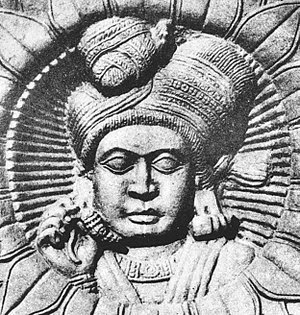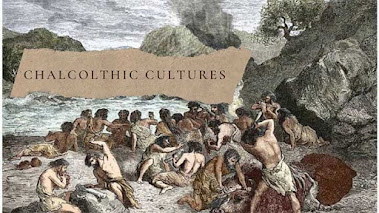The Pushyabhuti Dynasty
Pushyabhuti dynasty
The Pushyabhuti dynasty also known as the Vardhana
dynasty, ruled parts of northern India during 6th and 7th centuries.
The dynasty reached its zenith under its last ruler Harsha-Vardhana (c. 590–647
CE), whose empire, the Empire of Harsha, covered much of north and
north-western India, and extended till Kamarupa in the east and Narmada River
in the south.
Rulers
The following are the known rulers of the
Pushyabhuti or Vardhana dynasty, with estimated period of reign :
|
King |
Tenure |
|
Pushyabhuti |
Not Known |
|
Naravardhana |
500–525 CE |
|
Rajyavardana |
525–555 CE |
|
Adityavardhana |
555–580 CE |
|
Prabhakara-vardhana |
580–605 CE |
|
Rajya-vardhana |
605–606 CE |
|
Harsha-vardhana |
606–647 CE |
The most prominent ruler of the dynasty: “Harshavardhana”
Harsha (c. 590–647 CE), also known as
Harshavardhana, was an Indian emperor who ruled North India from 606 to 647 CE.
He was the son of Prabhakarvardhana who defeated the Huna invaders,and the
younger brother of Rajyavardhana, a king of Thanesar, present-day Haryana
(Kurukshetra 160 KM from Delhi).
At the height of Harsha’s power, his Empire
covered much of North and Northwestern India, extended East till Kamarupa, and
South until Narmada River; and eventually made Kannauj his capital and ruled
till 647 CE.
Administration
Harsha maintained the administrative set-up of his empire on the model of
previous great Hindu rulers. He himself was the head of the state, and all
administrative, legislative and judicial powers were concentrated in his hands.
He was also the first Commander-in-Chief of
his army. Harsha assumed the title of Maharajadhiraja. The king was assisted by
a council of ministers which was quite effective.
|
Key ranks held by officers |
Meaning |
|
Avanti |
Affairs of war and peace |
|
Singhanada |
Commander-in-Chief |
|
Kuntala |
Head of the cavalry |
|
Samanta-Maharaja |
Head of the civil administration |
The empire was divided into bhuktis
(provinces) and then further into vishayas (districts) for the sake of
administrative convenience. The village was the smallest unit of
administration.
The high officers were paid in terms of
jagirs (land) for their services, giving rise to Jagiradari (feudalism).
Prayag Assembly
Harsha did not put much burden of taxation
on his subjects and also reduced the administrative expenditure of the state.
The primary source of income of the state
was land revenue called bhaga which was 1/6th of the produce and was paid in
kind. Hirnya, Bali, sales-tax, toll tax etc. were other sources of income
besides presentation by feudatory chiefs to the emperor.
Harsha organised religious assemblies every
fifth year of his reign at Prayag (Allahabad). He held six such assemblies
during his reign. Whatever was left in the state treasury after five years,
Harsha used to give it all in charity at that time. It is said that he used to
distribute in charity even his personal belongings.
Army
Harsha kept a strong standing army at the
Centre. The cavalry, the infantry, chariots and war-elephants were the chief
constituents of his army.
According to Hiuen Tsang the army of
Harsha constituted 60,000 war-elephants, 50,000 strong cavalry and 1,00,000
strong infantry. Hiuen Tsang described that the war elephants were given swords
in their trunks. The Commander-in-Chief fought while on the back of an
elephant. The chariots were drawn by four horses. High officers sat in them
while fighting.
Social Condition
The four-fold division of the Hindu society
in castes continued to be effective though, of course, sub-castes were also
emerging. The caste-system was getting more rigid though interdining and
intercaste marriages were possible.
The practice of Sati was getting
encouragement, though restricted only to higher castes. There was no Purdah
system but there were several restrictions on the movements of women in society.
People pursued a simple and moral life and avoided consumption of meat, onion
and liquor.
Architecture
The architecture during Harsha’s period was
based on Gupta style primarily. Hiuen Tsang refers to a 8 feet tall copper
Buddha statue. He also talk of a multistory monastery at Nalanda. In
Chhattisgarh at Sirpur, a brick temple of Lakshman is surviving example of
architecture during Harsh’a period.
Economic Conditions
In general, there was prosperity within the
empire. Agriculture, industries and trade, both internal and external, were in
a flourishing condition.
Prayag (Allahabad), Banaras and Kannauj
were prosperous cities within the empire.The capital city, Kannauj was an
extensive, prosperous and well protected city. It had large buildings, beautiful
gardens and swimming-pools. It was inhabited by the rich, cultured and highly
learned people. The people, in general, were interested in literary activities
and fine arts.
Religious Conditions
Hinduism, Jainism and Buddhism were still
the popular religions in India. Prayag and Banaras were the main
centres of Hinduism. The popular sect of Buddhism was Mahayana.
Harsha was attracted towards Buddhism. He
is said to have erected many Buddhist Stupas and monasteries.
He prohibited the slaughter of animals and
made arrangements for free supply of food and medicines to the poor and the
destitute. Harsha was never a convert to Buddhism and continued to worship Siva
and Surya even during the later period of his life.
Learning and Literature
Harsha himself was a scholar and wrote
three Sanskrit plays, entitled the Nagananda, the Ratnavali and the
Priyadarsika. Harsha was a patron of learning and scholars. It has been said
that he spent ¼ of his income on education and learning.
The universities of Nalanda, Vallabhi and
the one run by Divakara in Vindhya forest were centres of learning at that
time. There, facilities were available not only for the study of philosophy but
that of law and physical sciences as well.
Among universities, the University of Nalanda was the most celebrated where students and scholars from all parts of the country as well as from foreign countries gathered for education and learning.
- By Prajwal Kumbhar
References
1. Infosrf.com
(Dynasty, Administration, Life Struggle of Emperor Harshavardhana)
2.
NCERT - Our Past-I
3.
Image ref-
https://en.wikipedia.org/wiki/Pushyabhuti_dynasty
NOTE :-
This blog is meant for Educational Purpose only .We do not own any Copyrights related to images and information , all the rights goes to their respective owners . The sole purpose of this blog is to Educate, Inspire, Empower and to create awareness in the viewers. The usage is non-commercial(Not For Profit) and we do not make any money from it.
FOLLOW US ON:-
INSTAGRAM :
https://bit.ly/coep_blogs_insta
LINKEDIN:
https://bit.ly/coep_blogs_linkedIn
YOUTUBE:-
https://bit.ly/Coep_blogs_YouTube







Comments
Post a Comment